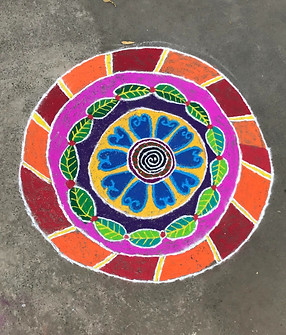Rangoli
Of all the practices I had practised in India, Rangoli had a particular impact on me since my early childhood. I made Rangolis during Diwali festival every year for 20 years in India. Traditionally, Rangolis are a floor art made in the threshold of the house by womenfolk every morning with the rising sun and is cleaned in the evening after the sunsets. This temporal design reminded one of her/his temporal life in the world. Rangoli are intricate designs comprising of lines, dots, motifs found in nature and animal figures. In ancient times, Rangolis were made using rice flour, sand, flowers, branches, dried leaves, turmeric, and so on, feeding insects and tiny creatures, and thus, reflecting the epitome of Indian culture ‘Vasudhaiva Kutumkambh’ (the whole world is one single family). As the houses I lived in Portsmouth did not offer a semi-covered threshold between the private and public space, protecting the Rangoli from weather and strong winds, I could not make Rangoli.
Making of a Rangoli is considered a living tradition in India, practised mainly through womenfolk for eras; although modified throughout, its significance has remained the same. This art form is believed to have survived even before it found a place in Hindu literature. This floor art has found its place not only in Indian domestic lives but in religious lives too (Rangoli, n.d.). Rangoli is a gesture of hospitality and openness for the visiting guests, be they human beings or heavenly beings. He maintains that the rice dust sprinkled on the floor to draw patterns, in the form of Rangoli, offered back to nature so the small creatures/insects/birds can feed on it. It reflects the Indian philosophy of oneness with nature nurturing all living entities' well-being –the essence of "Vasudhaiva Kutumbhkam": the whole world is one single family (The Tradition of Rangoli, n.d.).
It also asserts that one needs much patience to complete the Rangoli precisely. That is why the dots and lines that are used to draw patterns are believed to symbolise hurdles, hardships, and struggles that human beings face in life; and only after finishing the project denotes that if humans bravely, patiently, and serenely face all the struggles and hardships, they can get through life easily and peacefully (Rangoli, n.d.). On this, Adir et al., in their research, suggest that kids who learn to make Rangoli when they are young can develop the skill of creative problem-solving. As Rangoli is a collectively made project, they learn to work with others patiently, acquiring eye-hand coordination and fine muscle control to cultivate their social skills (Adir et al., 2010).



